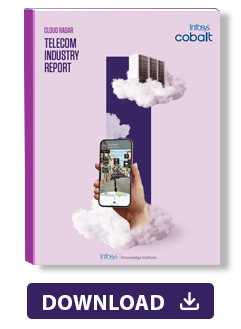Insights
- Telecom companies are increasingly turning to cloud-driven platform architectures influenced by 5G, IoT, and edge computing to deliver high-speed connectivity and low-latency services for a wide range of applications.
- Cloud migration efforts have proven to be very effective or extremely effective for 77% of telecom executives surveyed, and has resulted in significant cost savings and improved performance.
- The adoption of cloud-native network functions (CNFs) is pivotal in the transformation of the industry to align with diverse demands of 5G applications.
- Cloud-based radio access networks (C-RAN) allow operators to optimize network resources, accelerate service deployment and improve service quality.
Executive summary
Cloud spending in the telecommunications industry is set to increase in the coming year. Although telecoms were slow to adopt cloud due to migration complexities and security concerns, they are now investing significantly in network cloud transformation. Factors such as reduced cost, better operational efficiencies, and scalability are driving this move, according to Infosys Knowledge Institute research.
Cloud Radar surveyed more than 2,500 respondents from companies across nine industries — in Australia, France, Germany, New Zealand, UK, US, and the Nordic countries, including Denmark, Finland, Iceland, Norway, and Sweden. The study surveyed 401 respondents from telecom companies.
The research found that telecom companies depend on cloud for the deployment of new services, scalability, growth, and technology transformation.
In addition to traditional telecom services, cloud is particularly valuable for 5G deployment and offering new services, such as internet of things (IoT), machine-to-machine communication, and robotics.
Cloud is critical for the telecom ecosystem of service providers, partners, and end users to enable service agility, innovation, and global reach.
Telecom companies are generally satisfied with the results delivered by cloud but also face challenges when it comes to cloud usage, competition, and cost.

Cloud computing in telecom
Telecommunications has undergone a significant evolution, transitioning from traditional analog phone calls over copper wires to voice over internet protocol services. Today, the industry is primarily influenced by 5G, IoT, and edge computing — all leading telecom companies toward cloud-driven platform architectures.
“5G will be a game changer that strengthens telecom network infrastructure,” says Manjunath Kulkarni, associate vice president and delivery head of network services, Infosys. “The evolution of 5G networks brings exciting trends like edge computing, network slicing, IoT, artificial intelligence (AI), and cloud services,” he adds.
Cloud enables telecom operators to deploy, manage, and scale these complex 5G networks efficiently, ensuring high-speed connectivity and low-latency services for a wide range of applications.
What started with telecom companies outsourcing back-office IT functions has now progressed to migrating network workloads. A crucial shift started in 2012 when AT&T, Deutsche Telekom, Orange, and other major operators adopted the network function virtualization (NFV) framework and virtualized network functionality (VNF) applications. The applications, built on the NFV infrastructure, are now cloud native and virtualize tasks and features traditionally performed by hardware, such as routing, firewalls, load balancing, and encryption.
The convergence of 5G, IoT, and edge computing in telecoms is accelerating this transformation, enabling companies to deliver agile, scalable, high-performance services. Cloud-native architectures and NFV technologies are redefining operations, paving the way for a more connected and responsive digital future.

Cloud is for service and streamlining
Globe Telecom, a major telecommunications provider in the Philippines, migrated its IT environment to Amazon Web Services (AWS). They saw immediate benefits after the migration, achieving a four-fold performance increase and saving $1 million in license and support fees. The move enabled them to deliver scalable platforms and increase agility, all while significantly reducing costs, according to Pebbles Sy-Manalang, Globe's chief information officer.
In the Philippines and beyond, cloud is working well for telecom companies. As shown in Figure 1, of the 401 telecom executives surveyed by Infosys, 77% say cloud migration efforts are very effective or extremely effective. Overall, 73% of business leaders across all industries agree with that statement.
Figure 1. Cloud migration is meeting companies’ expectations
Source: Infosys Knowledge Institute (N=403)
Telecom leaders say they now move to cloud for growth and transformation: replace or update outdated systems, enable new revenue streams or products, access new technologies, and integrate acquisitions or subsidiaries (Figure 2).
Figure 2. Companies want growth and transformation from cloud
Source: Infosys Knowledge Institute
The adoption of cloud-native network functions (CNFs) is pivotal in this transformation. CNFs incorporate microservices, continuous integration and deployment pipelines, and dynamic orchestration. This architectural flexibility aligns well with diverse demands of 5G applications.
Cloud-based radio access network, or C-RAN, is a transformative approach to mobile network infrastructure that leverages CNF. Unlike traditional RAN, which relies on physical base stations, C-RAN virtualizes these functions in the cloud.
Network cloud transformation through C-RAN allows operators to optimize their network resources, accelerate service deployment, improve service quality, and utilize data insights.
Moreover, C-RAN's virtualized architecture enhances reliability by reducing hardware dependencies and providing centralized management.
Raja Shah, executive vice president and industry head of energy, communications, utilities and services, Infosys, says this about cloud-based radio access network: “Reliable platforms are required to capture, process and store data for industrial IoT services such as assembly line automation and robotic surgery. A cloud-based RAN enables network operators to deliver high-speed service and ensure efficient data transmission while rationalizing investment in base stations.”
Telecom cloud spending in line with industry average
Telecommunications companies surveyed spend $32 million annually on cloud services, nearly matching the industry average of $33 million (Figure 3).
Figure 3. Average cloud spend compared
Source: Infosys Knowledge Institute
That figure reflects only spending on cloud services, with additional investment required in infrastructure upgrades for telecom companies to maximize the utilization of cloud transformation.
As illustrated in Figure 4, telecom executives tell us that cloud spending will remain robust: Two out of three respondents increased cloud spending in 2023, and three out of four will do so in the year ahead. This is in line with overall corporate cloud trends. As cloud computing evolves, telecom companies are leveraging its advanced capabilities to phase out legacy technologies and integrate new functionalities into their operations.
Figure 4. Cloud spending continues to increase
Source: Infosys Knowledge Institute
Overprovisioning and underutilization
It’s very easy to add new cloud or replace old systems with new cloud deployments. However, telecom companies aren’t using all the cloud that they have already provisioned. Our survey found that telecom companies consume only 48% of the cloud they are committed to (Figure 5)
Figure 5. Telecom companies have used on average 48% of the cloud they’ve committed to
Source: Infosys Knowledge Institute (N=401)
The slow uptake can be attributed to the complexities of transitioning from legacy IT systems to cloud platforms, which often involves intricate interdependencies and customizations. Furthermore, while cloud adoption promises enhanced operational efficiency and scalability, telecoms face strategic challenges since cloud providers are sometimes competitors. Cloud service providers now offer telecom services, including edge computing, IoT platforms, and NFVs themselves. This makes some telecom companies cautious about fully migrating their services to cloud.
A decade on, cloud has changed to multicloud
The nature of corporate cloud has changed. Most companies, including telecoms, began their move to the cloud a decade ago. As shown in Figure 6, the prime era of that initial cloud migration across industries was from 2012 to 2014.
The telecom industry transitioned from proprietary hardware and systems to virtualized network functions around 2012 with the advent of NFV. This shift enabled telecom operators to replace outdated technology by migrating network functions from purpose-built hardware to virtual machines using technologies like VMware products and kernel-based virtual machines. This move aimed to reduce costs, enhance scalability, and improve operational efficiency across telecom networks.
Figure 6. Most companies began cloud migration about a decade ago
Source: Infosys Knowledge Institute
Most telecom businesses now employ three to four cloud providers. In 2021, Infosys found that most companies used two or three cloud providers, and 21% lived in a monocloud world. In 2023, the monocloud community is down to 7%, and 8% among telecom firms (Figure 7).
Figure 7. Three to four cloud vendors has become the norm, using one is rarely done
Source: Infosys Knowledge Institute
Today, cloud is not just about infrastructure or storage. It is multicloud, and most often hybrid multicloud.
Telecom providers are increasingly adopting multicloud strategies to deliver 5G services efficiently and meet evolving consumer needs.
By partnering with multiple public cloud providers and utilizing edge computing, telecoms enhance service agility, scalability, and support for latency-sensitive applications. The multicloud approach ensures compliance with local regulations, and enables secure service delivery, including edge-based AI and machine learning technologies.
Cloud transformations lead to new challenges in telecom
Cloud works well and delivers on increasingly sophisticated tasks. But as cloud systems advance, additional complexities emerge.
Our research reveals that telecom cloud managers are generally confident in their ability to run their systems. But they are least confident in monitoring, predicting, and optimizing cloud costs (Figure 8).
Figure 8. Cost complexity: Cost management is an emerging challenge
Source: Infosys Knowledge Institute
Telecoms often struggle with optimizing cloud costs, as highlighted by a 2022 survey revealing that 94% of enterprises overpay due to underused resources. Inefficient usage patterns, such as idle instances and overprovisioned resources, exacerbate these challenges, contributing significantly to bloated cloud bills. Additionally, the ease of self-service cloud provisioning by developers can lead to uncontrolled resource allocation, further complicating cost management efforts.
In addition to high and unchecked costs, sophisticated cloud systems can open up new cybersecurity challenges. The adoption of cloud-native 5G networks and virtualization can expose data to interception. Cloud-based assets, including numerous software as a service apps and databases, are primary targets for cyberthreats, exacerbated by the proliferation of IoT devices susceptible to botnet attacks. Human errors in configuration contribute significantly to system vulnerabilities.
Our research found that 45% of telecom respondents allow any department head or IT manager to deploy new cloud infrastructure, software, or applications (Figure 9). That is too lax from a security perspective but must be balanced against the dynamic demands of business.
Figure 9. Security complexity: Innovation in cloud creates new security challenges
Source: Infosys Knowledge Institute
IT versus business collaboration challenges
Cloud today is a domain where business and IT must work together. Modern cloud requires many elements to integrate smoothly, and that demands both technical and strategic thinking.
However, as shown in Figure 10, when we asked about a range of critical cloud decisions, we found that 44% are made in isolation. Considering that cloud saturates every corner of the corporate enterprise, decisions about cloud need to involve leaders, technologists, and users.
Figure 10. Ownership complexity: Decisions made in isolation and without a business case
Source: Infosys Knowledge Institute
In any sector, the collaboration between technologists and business teams is crucial to take full advantage of modular microservices, implementing agile DevOps practices, and integrating open APIs and service meshes. Only with this collective approach can an enterprise ensure enhanced scalability, security, and innovation flexibility.

The cloud forecast: Useful data, analytics, and AI
Despite initial reservations due to migration complexities and security concerns, telecoms are now aggressively pursuing cloud-driven network transformations. This shift is driven by the allure of improved operational efficiencies and scalability, as well as the often unrealized goal of reduced costs.
Telecom companies increasingly adopt cloud-based solutions to manage and analyze vast amounts of data generated by their networks and customer interactions. AI integrated into telecom cloud platforms significantly enhances these capabilities.
Anand Santhanam, senior vice president, head of strategy for media and telecommunications, Infosys says: "AI integrated into telecom cloud platforms brings dual benefits. It enhances predictive analytics and automates network management tasks on the technical front. At the same time, it enhances customer experience by personalizing services."
As 5G networks continue to expand and IoT devices proliferate, the telecom cloud becomes pivotal in handling massive data volumes and delivering real-time insights.
Appendix: Research approach
Qualitative interviews
To enrich our insights, we conducted phone interviews with more than 50 industry practitioners, executives, and subject matter experts.
Quantitative survey
Quantifying unused cloud commitments
The unrealized revenue figure of $300 billion is based on the declarations made by cloud service providers in their latest 10-K (or 20-F filing in case of foreign listed companies) to the Securities and Exchange Commission (SEC). To arrive at the unrealized revenue value, we searched for the following declarations in the liability section of the SEC filings of the company’s balance sheet: "unearned revenue," "deferred revenue," or "backlog revenue". Most of the cloud provider companies have declared these values as a part of a short-term or long-term liability on their balance sheets depending on the status of the contracts involved.
For the estimation, we recorded and then added unrealized revenues for cloud services providers covered in our study based on their SEC filings. We only included B2B unearned, deferred, or backlog revenues and excluded any declared unrealized revenues listed as a liability due to B2C subscriptions or services. For example, Microsoft Xbox and other personal subscriptions were recorded under personal cloud subscription services and were not included in our data analysis. Our research indicates that this $300 billion represents 53% of currently contracted cloud services. From this we estimate that the total amount of cloud services currently contracted exceeds $600 billion. Companies and their providers estimate the remaining $300 billion in unused cloud commitments will be consumed in the next three to five years but will likely be renegotiated and blended into a larger figure for longer contract terms.


















